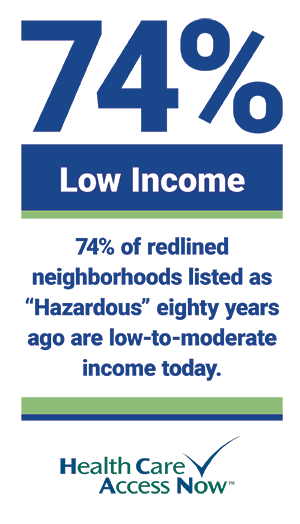Rents keep climbing, affecting health negatively

The practice of redlining, or racial segregation and discriminatory practices in the real estate industry, started to be exercised about a hundred years ago.

In many U.S. cities, certain neighborhoods were identified as “hazardous” based on the racial makeup of their inhabitants. Then, lending institutions used this information to deny home loans to people from Black communities. It became difficult—even impossible—to attain homeowner’s insurance in Black neighborhoods. Black people were also prevented from attaining loans to move into white neighborhoods. In the 1970s, these practices were exposed, and laws were put in place to prevent redlining.
The history of redlining is complex*, and its practices continue to affect Black communities. As a direct result of redlining, people of color in poverty tend to live in concentrated areas. “These neighborhoods generally lack healthy food options, top-performing public schools and quality medical care. High-poverty neighborhoods are also more likely to expose residents to crime and environmental hazards such as lead and smog,” according to the Annie E. Casey Foundation.
In Cincinnati, redlined areas included the West End/East Price Hill and Avondale/Walnut Hills. Some of these areas are now being gentrified, and long-time residents are being displaced or seeing their rents climb higher and higher, making suitable affordable housing less and less attainable.
What you can get vs. what’s available
It used to be that Cincinnati was counted among the more reasonable rental markets in the country. But the hot real estate market—with low inventory and skyrocketing home prices—is causing reverberations in the rental market as well. Now, the average monthly rental cost in Cincinnati is more than $1,000 per month. Realtor.com’s research on rental data placed Cincinnati at number 6 in the nation for “year-over-year rent increases.”
The affordable rent at minimum wage in Cincinnati, according to the National Low Income Housing Coalition (NLIHC) is $458 per month. The “estimated mean renter wage” in the area is $16.24 per hour, making the affordable rent $844 per month. So, even if a renter in Cincinnati makes almost twice the income of a minimum wage worker, that renter is still allotting more than 30% their income toward rent. And that means that person has less money to put toward other necessities, such as healthy food or prescriptions and other health care costs.
Low-income renters can apply for housing vouchers, but landlords can (and often do) refuse to accept Housing Choice Vouchers (formerly known as Section 8) renters. Health Care Access Now’s Community Health Workers do what they can to facilitate the process and educate clients on their options, but accessing suitable housing continues to be one of the greatest challenges their clients face.
*More can be found about the history of redlining in a variety of sources, including:
- The Color of Law, a book by former New York Times columnist Richard Rothstein.
- The National Community Reinvestment Coalition’s research.
- The University of Richmond’s Mapping Inequality site.






